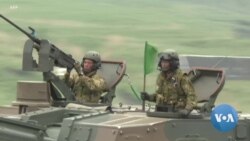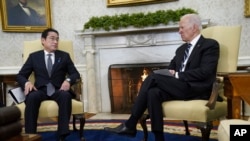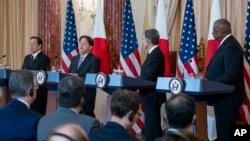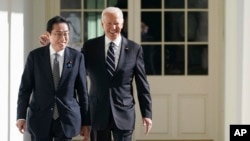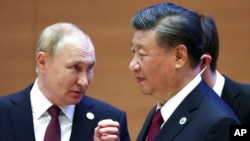U.S. President Joe Biden on Friday commended Japanese Prime Minister Fumio Kishida for boosting Japan’s military spending and drastically changing its defense posture, and he called out threats from China, North Korea and Russia as reasons behind the two countries’ decision to ramp up their collective security.
Biden conveyed this to Kishida in a White House meeting that underscored the deepening U.S.-Japan strategic alliance and Tokyo’s growing sense of vulnerability amid regional security threats, mainly from China, and Russia’s invasion of Ukraine.
"The United States is fully, thoroughly, completely committed to the alliance,” Biden said. “And more importantly, to Japan's defense.”
In a joint statement released by the White House, the leaders called out “actions inconsistent with the rules-based international order by China” and “provocations by North Korea” as sources of the challenges faced in the Indo-Pacific, and Russia’s “unjust and brutal war of aggression against Ukraine.”
"We strongly oppose any unilateral attempts to change the status quo by force or coercion, anywhere in the world,” the statement said. “Taken together, this landscape demands that the United States and Japan continue to strengthen our individual and collective capacity.”
Change in defense posture
Ahead of the Biden-Kishida summit, U.S. Secretary of State Antony Blinken and Defense Secretary Lloyd Austin, along with their Japanese counterparts, Foreign Minister Yoshimasa Hayashi and Defense Minister Yasukazu Hamada, launched a series of changes in defense posture, military training arrangements and command relationships, including plans to reorganize U.S. Marine Corps units based on Okinawa.
The changes, announced Wednesday in Washington, signaled that the two allies are taking more seriously the possibility of war in the Indo-Pacific in the event of a Chinese attack on Taiwan or North Korea’s nuclear strikes. It puts in force Japan’s new National Security Strategy, released in December, that warns of the possibility that “a serious situation may arise in the future in the Indo-Pacific region, especially in East Asia,” and calls for long-range “counterstrike” capability that would enable it to reach targets in mainland China.
"Japan and the United States are currently facing the most challenging and complex security environment in recent history,” Kishida said through an interpreter, touting his country’s national security strategy that he said would "ensure peace and prosperity in the region.”
Kishida’s government also plans to double Japan's defense budget to almost 2% of its gross domestic product by 2027, which would put the nation into the world’s top five in military spending.
The moves came with the blessing of the White House, press secretary Karine Jean-Pierre said Wednesday in a briefing, underscoring that Japan’s national security strategy and commitment to boosting its defense “will strengthen deterrence in the region in order to advance peace and stability in the Indo-Pacific and globally.”
While Tokyo has gradually been bolstering its defense capabilities over the past decade in response to ramped-up Chinese military activities in the South China Sea, the waters around Taiwan and the East China Sea — particularly around the Senkakus, a group of islands claimed by Japan, China and Taiwan — the announcements made within the past month surprised many observers.
“Nobody thought it was going to happen this quickly,” said Jeffrey Hornung, senior political scientist specializing in Japanese and East Asian security at the Rand Corporation, a global policy research group. “Nobody thought it was going to happen under this prime minister, who is not known as a defense hawk by any means. And yet, he's essentially turning over Japan's postwar defense policy in a way that nobody had envisioned,” Hornung told VOA.
Kishida is currently facing low approval ratings at home due to various scandals involving his Cabinet members.
War in Ukraine jars Japanese
A Chinese attack on Taiwan is still hypothetical, but Russia’s war on Ukraine has awakened the Japanese public to the possibility of one country invading another. That, combined with China’s dispatch of its warships and fighter jets and firing of ballistic missiles around Taiwan in response to then-U.S. House Speaker Nancy Pelosi’s visit to the island last year, spooked people, said Zack Cooper, a senior fellow focusing on U.S. strategy in Asia at the American Enterprise Institute.
“Those two actions by [Chinese President] Xi Jinping, by [Russian President] Vladimir Putin, have convinced many in Tokyo that, look, especially in these autocratic countries that are run largely by one leader, you just can't be that confident in the actions they’re going to take,” Cooper told VOA. “And so, Japan has to step up much more actively now than it had been prepared to do so before.”
In the event of a Chinese attack on Taiwan spilling over, Tokyo is seeking to bolster the capacity to protect itself and support the estimated 50,000 American troops operating in Japan. This would help the U.S. in its likely move to defend Taipei in a conflict with China.
“For us to have any shot at trying to push back aggression, we need a very strong Japan,” Hornung said.
Holding Russia responsible
Tokyo’s backing of U.S.-led efforts to place sanctions on Moscow and provide Ukraine with financial, humanitarian and nonlethal military support was instrumental in securing the support of other non-NATO partners, including South Korea, Australia and Singapore.
“If Japan had not done this, those other countries would be much more hesitant. It would be seen much more as a trans-Atlantic response to Russia's invasion of Ukraine, rather than a global response from leading democracies,” Cooper said.
Before Washington, Kishida visited France, Italy, the United Kingdom and Canada to coordinate an approach to Ukraine and other agenda items for the Group of 7 summit in May that Japan will host. Officials say Japan will use its G-7 chairmanship and its two-year term at the U.N. Security Council to continue pressing Russia to stop its war.
Differences on trade
While the China and Russia threats have brought the allies closer, the U.S. and Japan have remained apart on trade since then-President Donald Trump’s 2017 withdrawal of the United States from the Trans-Pacific Partnership, a free-trade agreement pushed in 2015 by then-President Barack Obama and then-Prime Minister Shinzo Abe.
Japan went ahead with the deal, which eventually became the 2018 Comprehensive and Progressive Agreement for Trans-Pacific Partnership, an 11-country bloc representing one of the largest free-trade areas in the world.
Despite repeated urging by Tokyo, the Biden administration has not joined the CPTPP.
“This is not an option we're exploring,” Jean-Pierre said in Friday’s White House briefing to reporters.
Any kind of free-trade agreement is viewed as politically perilous at home, where protectionist sentiment runs high, a reality that Japan understands, said Shihoko Goto, director for geoeconomics and Indo-Pacific enterprise at the Wilson Center, a global policy research group.
“What will probably happen is CPTPP will be mentioned, but there’s not going to be any push to have the United States join,” Goto told VOA.
The U.S. and Japan launched the “Economic 2+2” dialogue in July, but the talks have focused on increasing economic security, such as securing supply chains, rather than trade liberalization.
Tokyo is expected to follow Washington’s steps to impose export controls on advanced semiconductors and other sensitive dual-use technologies to lessen Chinese economic clout. A Chinese foreign ministry spokesperson said Friday that Beijing would "pay close attention to the relevant move and resolutely safeguard its own interest."
Iuliia Iarmolenko contributed to this report.




